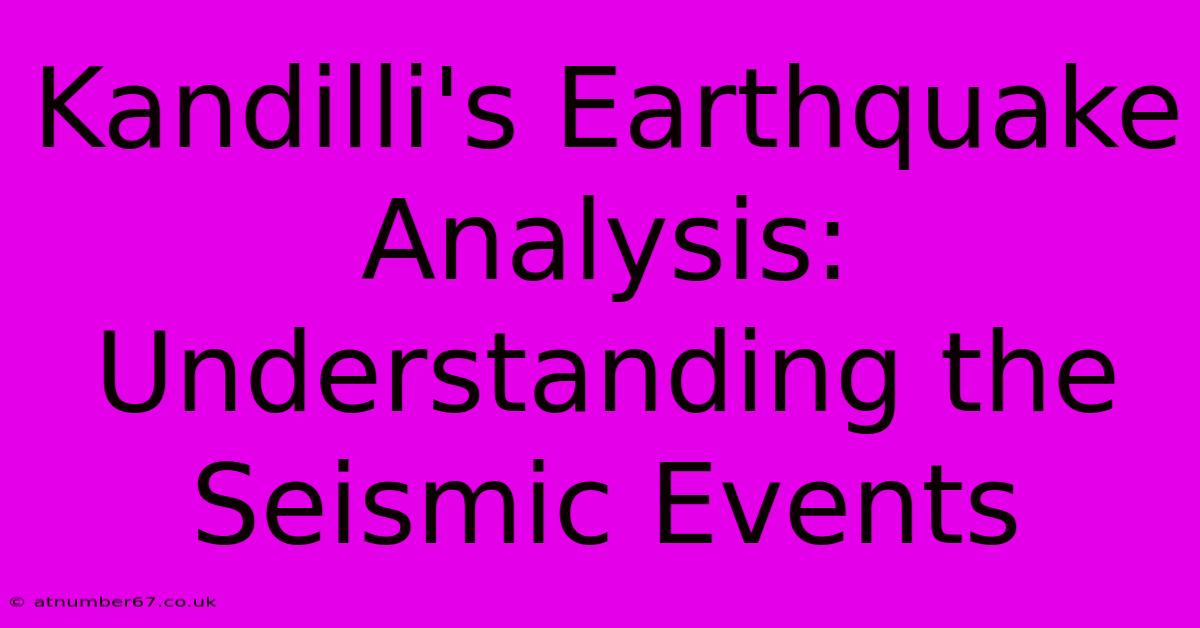Kandilli's Earthquake Analysis: Understanding The Seismic Events

Table of Contents
Kandilli's Earthquake Analysis: Understanding the Seismic Events
Kandilli Observatory and Earthquake Research Institute (KOERI) is a prominent institution in Turkey, playing a crucial role in monitoring and analyzing seismic activity in the region and beyond. Its earthquake analysis provides invaluable insights into the nature and impact of these events, contributing significantly to earthquake preparedness and risk mitigation. This article delves into the importance of Kandilli's work, the methods they employ, and the significance of their findings for understanding seismic events.
The Importance of Kandilli's Earthquake Monitoring
Turkey is located in a highly seismically active zone, situated on the boundary of several major tectonic plates. This geographical location makes the country particularly vulnerable to earthquakes of varying magnitudes. Kandilli Observatory's continuous monitoring is therefore paramount for:
- Early Warning Systems: Rapid and accurate detection of earthquakes allows for timely warnings, potentially giving people precious seconds to take protective measures.
- Seismic Hazard Assessment: Analyzing historical and current seismic data helps in assessing the risk of future earthquakes in specific regions. This information is crucial for building codes, land-use planning, and emergency preparedness strategies.
- Scientific Research: KOERI's research contributes to a deeper understanding of earthquake mechanics, fault behavior, and seismic wave propagation. This knowledge is essential for improving earthquake prediction models and developing more resilient infrastructure.
- Public Awareness: Kandilli's readily available data and reports educate the public about earthquake risks and promote preparedness. This public awareness is vital for reducing casualties and minimizing damage during seismic events.
Kandilli's Analytical Methods
Kandilli employs a sophisticated network of seismic monitoring stations equipped with advanced sensors. These stations detect even the slightest ground motion, providing precise data on earthquake location, magnitude, and depth. Their analysis involves:
- Seismic Wave Analysis: Studying the characteristics of seismic waves (P-waves, S-waves, surface waves) to determine the earthquake's source parameters.
- Location Algorithms: Using sophisticated algorithms to pinpoint the earthquake's epicenter and hypocenter (depth).
- Magnitude Estimation: Applying various magnitude scales (e.g., moment magnitude, Richter scale) to quantify the earthquake's size and energy release.
- Fault Plane Solutions: Determining the orientation and slip direction on the fault plane that caused the earthquake. This helps understand the stress field and tectonic processes involved.
- Data Integration and Modeling: Combining data from various sources and employing advanced computer modeling techniques to simulate earthquake scenarios and assess potential hazards.
Understanding the Significance of Kandilli's Findings
The detailed analysis provided by Kandilli Observatory is not just a collection of numbers; it's a crucial tool for:
- Improving Building Codes: Understanding the characteristics of past earthquakes informs the development of building codes that ensure structures can withstand seismic forces.
- Developing Early Warning Systems: Accurate and timely data is essential for creating effective early warning systems that can provide crucial seconds of warning before strong shaking arrives.
- Planning for Disaster Relief: Kandilli's analysis helps authorities plan effective disaster relief efforts by identifying areas most severely affected and assessing the extent of damage.
- Educating the Public: Public dissemination of information raises awareness, enabling communities to better prepare themselves and minimize risks.
- Advancing Scientific Knowledge: KOERI's research contributes significantly to the global understanding of earthquakes, ultimately leading to improved prediction models and risk mitigation strategies.
In conclusion, Kandilli Observatory and Earthquake Research Institute plays a vital role in understanding and mitigating the risks associated with earthquakes in Turkey and the surrounding region. Their continuous monitoring, sophisticated analysis, and commitment to public education are invaluable in saving lives and protecting infrastructure from the devastating effects of seismic events. The importance of their work cannot be overstated.

Thank you for visiting our website wich cover about Kandilli's Earthquake Analysis: Understanding The Seismic Events. We hope the information provided has been useful to you. Feel free to contact us if you have any questions or need further assistance. See you next time and dont miss to bookmark.
Featured Posts
-
Jayne Torvills Net Worth Beyond The Headlines
Mar 29, 2025
-
The Dhoni Age Effect Inspiring A Generation
Mar 29, 2025
-
Julia Montes How Her Age Shaped Her Career
Mar 29, 2025
-
Woody Allens Marriage Fact Vs Fiction
Mar 29, 2025
-
Understanding Lio Son Filss Vision
Mar 29, 2025
